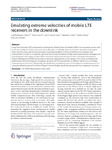Mostrar o rexistro simple do ítem
Emulating extreme velocities of mobile LTE receivers in the downlink
| dc.contributor.author | Rodríguez Piñeiro, José | |
| dc.contributor.author | Lerch, Martin | |
| dc.contributor.author | García-Naya, José A. | |
| dc.contributor.author | Caban, Sebastian | |
| dc.contributor.author | Rupp, Markus | |
| dc.contributor.author | Castedo, Luis | |
| dc.date.accessioned | 2024-03-08T20:21:31Z | |
| dc.date.available | 2024-03-08T20:21:31Z | |
| dc.date.issued | 2015 | |
| dc.identifier.citation | Rodríguez-Piñeiro, J., Lerch, M., García-Naya, J.A. et al. Emulating extreme velocities of mobile LTE receivers in the downlink. J Wireless Com Network 2015, 106 (2015). https://doi.org/10.1186/s13638-015-0343-0 | es_ES |
| dc.identifier.issn | 1687-1499 | |
| dc.identifier.issn | 1687-1472 | |
| dc.identifier.uri | http://hdl.handle.net/2183/35828 | |
| dc.description.abstract | [Abstract]: Long-Term Evolution (LTE) is expected to substitute the Global System for Mobile (GSM) Communications as the radio access technology for railway communications. Recently, considerable attention has been devoted to high-speed trains since this particular environment poses challenging problems in terms of performance simulation and measurement. In order to considerably decrease the cost and complexity of high-speed measurement campaigns, we have proposed a technique to induce effects caused by highly time-varying channels on Orthogonal Frequency-Division Multiplexing (OFDM) signals while conducting measurements at low speeds. In this work, we illustrate the performance of this technique by comparing the results of LTE measurements at different velocities in a controlled measurement environment. Additionally, we validate this technique by means of simulations, considering one of the scenarios defined as part of the Winner Phase II Channel Models, specifically designed for high-speed train scenarios. | es_ES |
| dc.description.sponsorship | This work has been funded by the Christian Doppler Laboratory for Wireless Technologies for Sustainable Mobility, KATHREIN Werke KG, and A1 Telekom Austria AG. This work was supported in part by the Xunta de Galicia, MINECO of Spain, and FEDER funds of the E.U. under Grant 2012/287, Grant IPT-2011-1034-370000, Grant TEC2013-47141-C4-1-R, Grant FPU12/04139, and Grant EST13/00272. The financial support by the Austrian Federal Ministry of Economy, Family and Youth and the National Foundation for Research, Technology and Development is gratefully acknowledged. | es_ES |
| dc.description.sponsorship | Xunta de Galicia; 2012/287 | es_ES |
| dc.language.iso | eng | es_ES |
| dc.publisher | SpringerOpen & European Association for Signal Processing | es_ES |
| dc.relation | info:eu-repo/grantAgreement/MINECO/Plan Estatal de Investigación Científica y Técnica y de Innovación 2013-2016/TEC2013-47141-C4-1-R/ES/TECNICAS DE ACCESO RADIO PARA REDES INALAMBRICAS HETEROGENEAS | es_ES |
| dc.relation | info:eu-repo/grantAgreement/MECD/Plan Nacional de I+D+i 2008-2011/FPU12%2F04139/ES/ | es_ES |
| dc.relation | info:eu-repo/grantAgreement/MECD/Plan Estatal de Investigación Científica y Técnica y de Innovación 2013-2016/EST13%2F00272/ES/ | es_ES |
| dc.relation | info:eu-repo/grantAgreement/MICINN/Plan Nacional de I+D+i 2008-2011/IPT-2011-1034-370000/ES/TECNOLOGÍAS DE COMUNICACIÓN LTE PARA LA CONDUCCIÓN AUTOMÁTICA Y EL CONTROL FERROVIARIO, TECRAIL | es_ES |
| dc.relation.uri | https://doi.org/10.1186/s13638-015-0343-0 | es_ES |
| dc.rights | Atribución 4.0 Internacional | es_ES |
| dc.rights.uri | http://creativecommons.org/licenses/by/3.0/es/ | * |
| dc.subject | LTE | es_ES |
| dc.subject | OFDM | es_ES |
| dc.subject | Measurement | es_ES |
| dc.subject | High speed | es_ES |
| dc.title | Emulating extreme velocities of mobile LTE receivers in the downlink | es_ES |
| dc.type | info:eu-repo/semantics/article | es_ES |
| dc.rights.access | info:eu-repo/semantics/openAccess | es_ES |
| UDC.journalTitle | EURASIP Journal on Wireless Communications and Networking | es_ES |
| UDC.volume | 2015 | es_ES |
| UDC.issue | 106 | es_ES |
| UDC.startPage | 1 | es_ES |
| UDC.endPage | 14 | es_ES |
| dc.identifier.doi | 10.1186/s13638-015-0343-0 |
Ficheiros no ítem
Este ítem aparece na(s) seguinte(s) colección(s)
-
GI-GTEC - Artigos [186]






